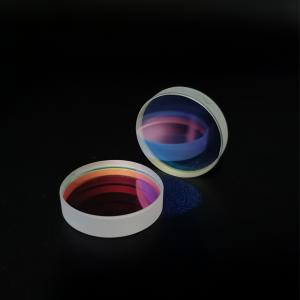Supplier: TianCheng Optics CO.,Ltd
Contact person: Mr. Aamina Gao
Position:
Address: No. 1567 Liu Ying Lu, Kuan Cheng District, Chang Chun,P.R. China
Country: China
Phone: - Mobi: 86-431-89851801
Dichroic Mirror
Price: 10
The ir dichroic mirror, augmented by colour filters that perfected their colour-selective action, directed a blue image to the first tube, a green image to the second, and a red image to the surface.
Dichroic Mirror Specification
Dichroic Mirrors Using Purproses
Tian Cheng Optics Co.,Ltd offers a wide choice of dichroic mirrors and IBS coated high transmission dichroic mirrors for different laser wavelengths.In a diode laser, a dichroic short-pass mirror in the resonator, placed next to the laser crystal, may be used for injecting pump light, while the circulating laser light is reflected to nearly 100%.In case of external frequency doubling, a dichroic mirror used as harmonic separatorIn laser microscopy, a dichroic mirror can be used for separating the fluorescence lightfrom the pump light.
Dichroic Mirrors Applications
Dichroic mirror polarization can split a beam into two parts of different wavelength without any appreciable loss of intensity. So it can be used in Laser industrial area and laser medical service.Dichroic mirrors is very significantfor filtering of spectral components, in splitting or combining two beams that have different wavelengths, and in fluorescence microscopy.Dichroic filters are used for such purposes in Raman spectroscopy, which uses high-intensity laser light to illuminate products.
How Does A Dichroic Mirror Work
Dichroic filters emit light directly from the light source, using a strong light source to remove unwanted wavelengths. Dichroic filters use thin-film interference to selectively and destructively interfere with certain wavelengths. Dichroic filters are fabricated using multiple layers in a thin-film cavity that includes materials of different refractive indices that are coated on an optical glass substrate. When light passes through the filter at a given angle of incidence, some of the light will be reflected by each thin layer within the cavity. Due to the different path lengths between the reflection points, the reflected light interferes with the incident light, some wavelengths are reflected and the rest are transmitted.
Because path length depends on the angle of incidence of the incident light, the performance of dichroic filters is angle-dependent. An increased angle of incidence causes the filter to shift to shorter wavelengths.
Dichroic Mirror Specification
Material | BK7 or Fused Silica |
Design Wavelength | 546.1 nm |
BK7 | 1.5183 ± 0.0005 |
Fused Silica | 1.46008±0.00005 |
Diameter Tolerance | +0.00, -0.15 mm |
Thickness Tolerance | ±0.2 mm |
Paraxial Focal Length | ±2% |
Centration | <3 arc minutes |
Clear Aperture | >85% |
Surface Irregularity | λ/4@632.8 nm |
Surface Quality | 60-40 scratch and dig |
Protective Bevel | 0.25 mm x 45° |
Dichroic Mirrors Using Purproses
Tian Cheng Optics Co.,Ltd offers a wide choice of dichroic mirrors and IBS coated high transmission dichroic mirrors for different laser wavelengths.In a diode laser, a dichroic short-pass mirror in the resonator, placed next to the laser crystal, may be used for injecting pump light, while the circulating laser light is reflected to nearly 100%.In case of external frequency doubling, a dichroic mirror used as harmonic separatorIn laser microscopy, a dichroic mirror can be used for separating the fluorescence lightfrom the pump light.
Dichroic Mirrors Applications
Dichroic mirror polarization can split a beam into two parts of different wavelength without any appreciable loss of intensity. So it can be used in Laser industrial area and laser medical service.Dichroic mirrors is very significantfor filtering of spectral components, in splitting or combining two beams that have different wavelengths, and in fluorescence microscopy.Dichroic filters are used for such purposes in Raman spectroscopy, which uses high-intensity laser light to illuminate products.
How Does A Dichroic Mirror Work
Dichroic filters emit light directly from the light source, using a strong light source to remove unwanted wavelengths. Dichroic filters use thin-film interference to selectively and destructively interfere with certain wavelengths. Dichroic filters are fabricated using multiple layers in a thin-film cavity that includes materials of different refractive indices that are coated on an optical glass substrate. When light passes through the filter at a given angle of incidence, some of the light will be reflected by each thin layer within the cavity. Due to the different path lengths between the reflection points, the reflected light interferes with the incident light, some wavelengths are reflected and the rest are transmitted.
Because path length depends on the angle of incidence of the incident light, the performance of dichroic filters is angle-dependent. An increased angle of incidence causes the filter to shift to shorter wavelengths.
SEND INQUIRY
Please fill in fully your information to send email
CATEGORY














 Agriculture
Agriculture